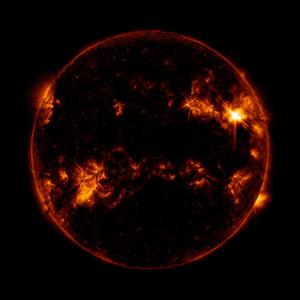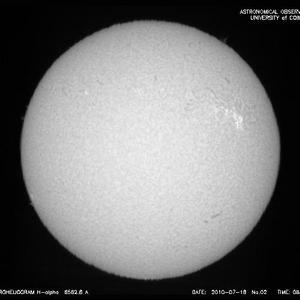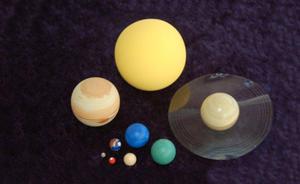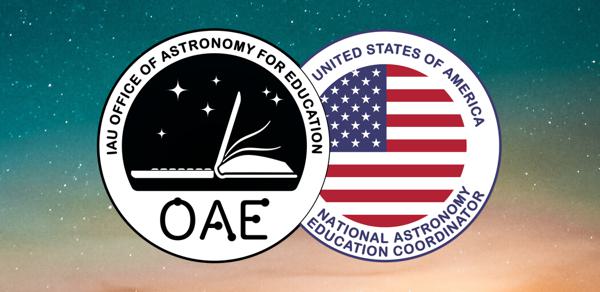Glossary term: Sun
Description: The Sun is the star that is closest to the Earth. For astronomers, it is a star of type "G2V". This means the Sun is a main sequence star with a typical temperature ("effective temperature") of 5800 kelvins (K). Main sequence stars are stable, with energy released by hydrogen fusion in their core balancing the inwards force due to gravity. The Sun appears white to the human eye as it emits lots of light all across the visible spectrum. When lower in the sky, increased atmospheric extinction can make the Sun appear yellow or orange, hence its common depiction as yellow. Stars range from more than 1000 times brighter than the Sun to some 1000 times fainter, but the brighter ones are relatively rare: the Sun is brighter (and heavier) than most (perhaps some 85%) of the stars in the Galaxy.
For astronomers, the Sun is interesting because of its proximity, which means that the surface can be resolved in greater detail, allowing structures and phenomena to be studied. For example, detailed studies of solar activity, which is related to the Sun's magnetic fields, can include: sunspots (cooler areas), flares (short-lived bright flashes), and even coronal mass ejections (electrically charged particles flung away from the Sun). Physicists have also detected elementary particles known as neutrinos from the Sun's core; this is direct evidence for nuclear fusion processes. The element helium was first detected in the solar spectrum, hence the name helium, which comes from Helios (in Greek mythology the Sun god).
Related Terms:
- Main Sequence
- Nuclear Fusion
- Solar Flare
- Star
- Sunspot
- Effective Temperature
- Magnetic Field
- Neutrino
- Coronal Mass Ejection (CME)
See this term in other languages
Term and definition status: This term and its definition have been approved by a research astronomer and a teacher
The OAE Multilingual Glossary is a project of the IAU Office of Astronomy for Education (OAE) in collaboration with the IAU Office of Astronomy Outreach (OAO). The terms and definitions were chosen, written and reviewed by a collective effort from the OAE, the OAE Centers and Nodes, the OAE National Astronomy Education Coordinators (NAECs) and other volunteers. You can find a full list of credits here. All glossary terms and their definitions are released under a Creative Commons CC BY-4.0 license and should be credited to "IAU OAE".
If you notice a factual error in this glossary definition then please get in touch.
Related Media
Winter Haloes, by Thomas Gigl, Germany
Credit: Thomas Gigl/IAU OAE
License: CC-BY-4.0 Creative Commons Attribution 4.0 International (CC BY 4.0) icons
Sunspots
Credit: NASA/SDO/HMI credit link
License: PD Public Domain icons
Solar flare
Credit: NASA/SDO credit link
License: PD Public Domain icons
Related Activities
Measure the Solar Diameter
astroEDU educational activity (links to astroEDU website) Description: Hands-on activity to measure the Sun by using household materials.
License: CC-BY-4.0 Creative Commons Attribution 4.0 International (CC BY 4.0) icons
Tags:
Hands-on
, Scales
, Observing
, Measurement
Age Ranges:
12-14
, 14-16
, 16-19
, 19+
Education Level:
Middle School
Areas of Learning:
Social Research
Costs:
Low Cost
Group Size:
Group
Skills:
Communicating information
, Constructing explanations
, Using mathematics and computational thinking
Counting Sunspots
astroEDU educational activity (links to astroEDU website) Description: Counting the Sunspots using real solar images and data.
License: CC-BY-4.0 Creative Commons Attribution 4.0 International (CC BY 4.0) icons
Tags:
Hands-on
, Sunspots
, Data analysis
Age Ranges:
16-19
Areas of Learning:
Observation based
Costs:
Low Cost
Duration:
1 hour
Group Size:
Group
Skills:
Analysing and interpreting data
, Constructing explanations
, Using mathematics and computational thinking
Meet Our Neighbours: Sun
astroEDU educational activity (links to astroEDU website) Description: Explore the tactile version of our star; the Sun with household materials.
License: CC-BY-4.0 Creative Commons Attribution 4.0 International (CC BY 4.0) icons
Tags:
Hands-on
, Model
, Sunspots
, Visually Impaired
, Tactile
Age Ranges:
6-8
, 8-10
, 10-12
Education Level:
Middle School
, Primary
, Secondary
Areas of Learning:
Interactive Lecture
, Modelling
Costs:
Low Cost
Duration:
1 hour
Group Size:
Group
Skills:
Analysing and interpreting data
, Developing and using models
Build a Safe Sun Viewer
astroEDU educational activity (links to astroEDU website) Description: Build a safe Sun viewer using cheap household items and learn why it is dangerous to look directly at the Sun, even briefly.
License: CC-BY-4.0 Creative Commons Attribution 4.0 International (CC BY 4.0) icons
Tags:
Hands-on
, Safety
Age Ranges:
6-8
, 8-10
, 10-12
Education Level:
Primary
, Secondary
Areas of Learning:
Modelling
, Observation based
Costs:
Low Cost
Group Size:
Group
Skills:
Planning and carrying out investigations
Solar System Model
astroEDU educational activity (links to astroEDU website) Description: Make a model of the Solar System planets using household materials.
License: CC-BY-4.0 Creative Commons Attribution 4.0 International (CC BY 4.0) icons
Tags:
Hands-on
, Model
, Planets
Age Ranges:
4-6
, 6-8
, 8-10
Education Level:
Pre-school
, Primary
Areas of Learning:
Modelling
Costs:
Low Cost
Duration:
30 mins
Group Size:
Group
Skills:
Analysing and interpreting data
, Asking questions
, Communicating information
, Developing and using models
















